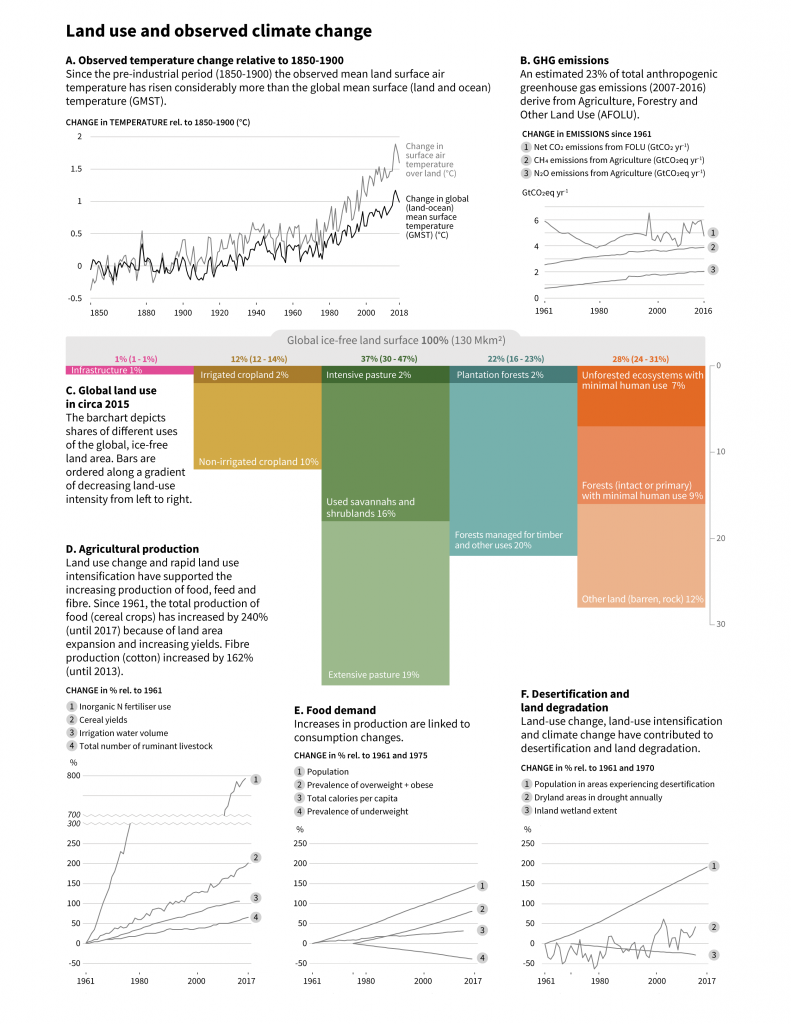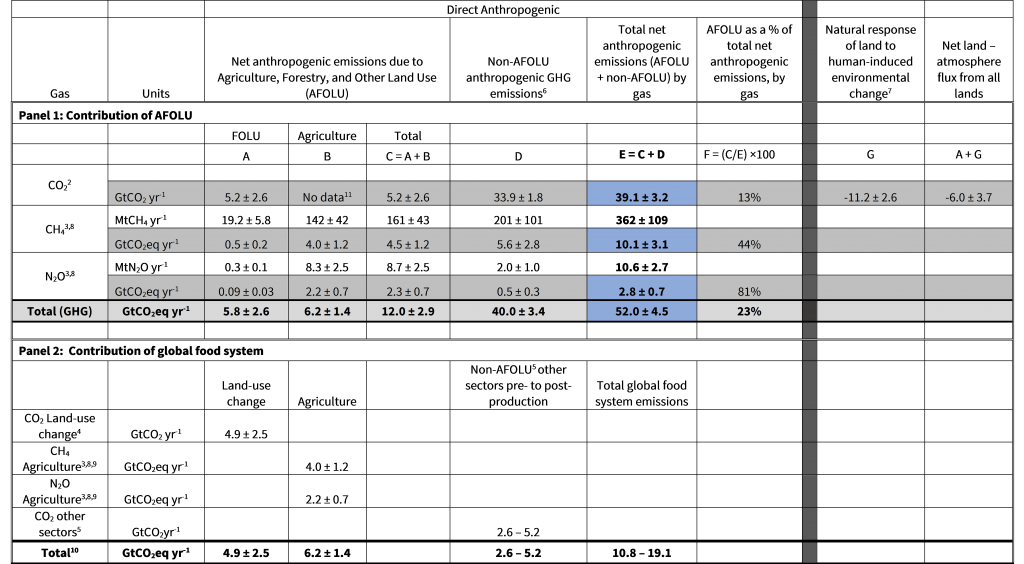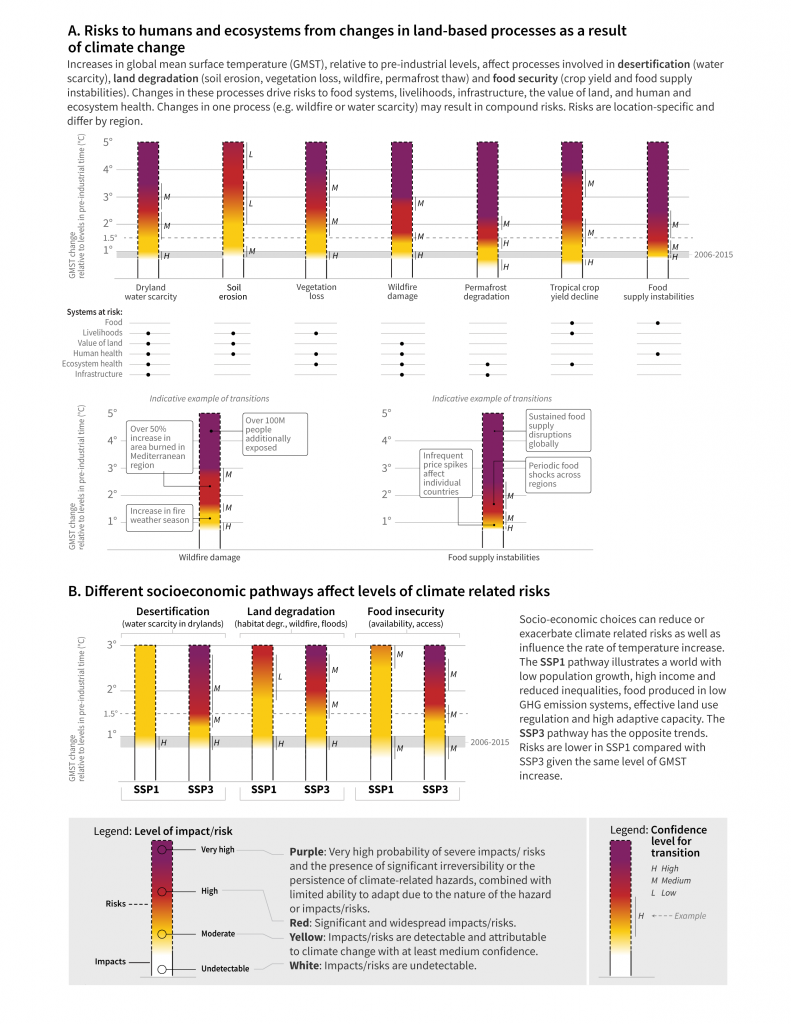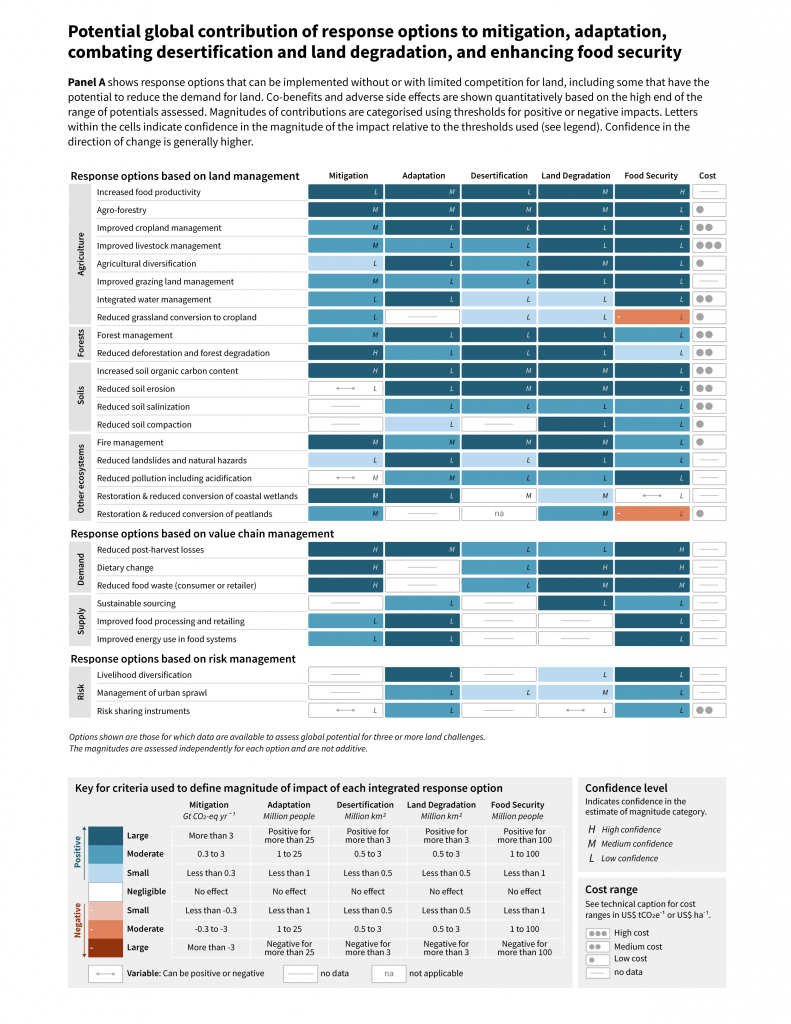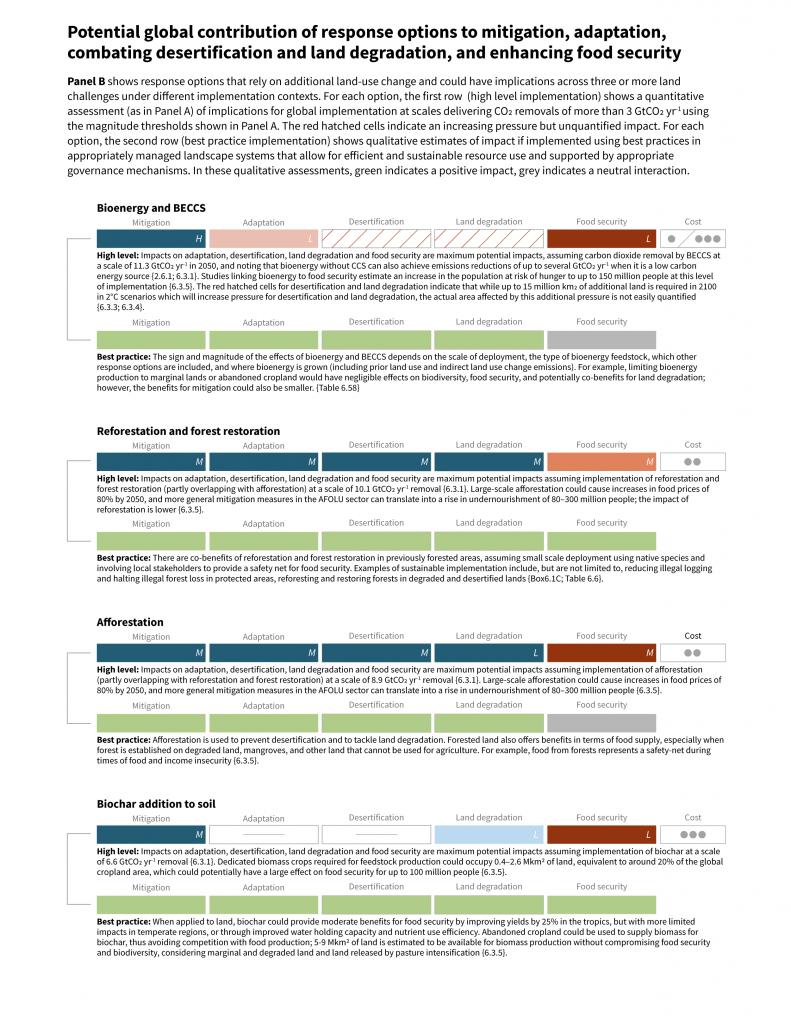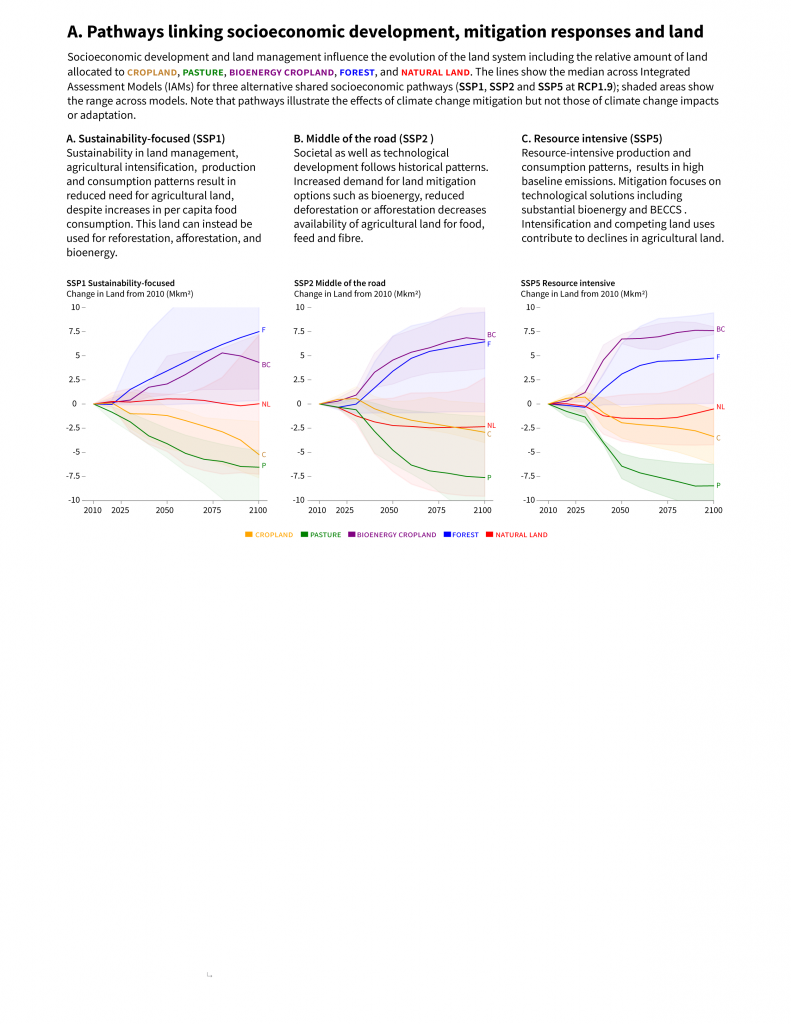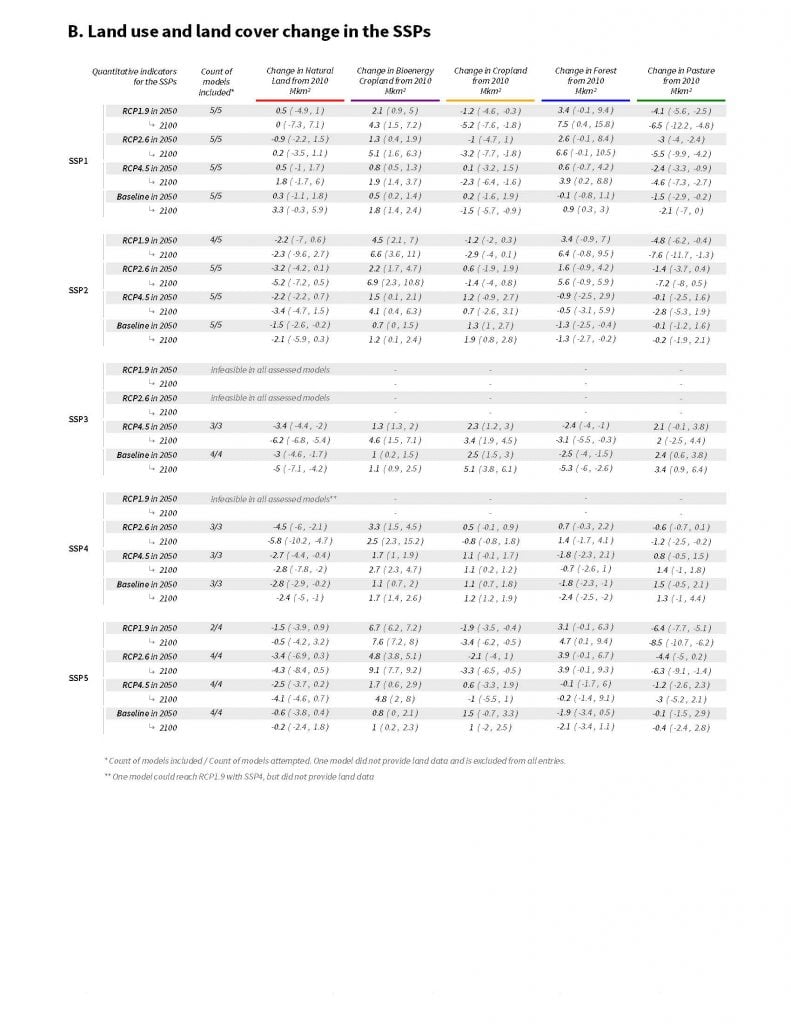B.1
Many land-related responses that contribute to climate change adaptation and mitigation can also combat desertification and land degradation and enhance food security. The potential for land-related responses and the relative emphasis on adaptation and mitigation is context specific, including the adaptive capacities of communities and regions. While land-related response options can make important contributions to adaptation and mitigation, there are some barriers to adaptation and limits to their contribution to global mitigation. (very high confidence) (Figure SPM.3) {2.6, 4.8, 5.6, 6.1, 6.3, 6.4}
B.1.1
Some land-related actions are already being taken that contribute to climate change adaptation, mitigation and sustainable development. The response options were assessed across adaptation, mitigation, combating desertification and land degradation, food security and sustainable development, and a select set of options deliver across all of these challenges. These options include, but are not limited to, sustainable food production, improved and sustainable forest management, soil organic carbon management, ecosystem conservation and land restoration, reduced deforestation and degradation, and reduced food loss and waste (high confidence). These response options require integration of biophysical, socioeconomic and other enabling factors. {6.3, 6.4.5, 7.5.6, Cross-Chapter Box 10 in Chapter 7}
B.1.2
While some response options have immediate impacts, others take decades to deliver measurable results. Examples of response options with immediate impacts include the conservation of high-carbon ecosystems such as peatlands, wetlands, rangelands, mangroves and forests. Examples that provide multiple ecosystem services and functions, but take more time to deliver, include afforestation and reforestation as well as the restoration of high-carbon ecosystems, agroforestry, and the reclamation of degraded soils (high confidence). {6.4.5, 7.5.6, Cross-Chapter Box 10 in Chapter 7}
B.1.3
The successful implementation of response options depends on consideration of local environmental and socio-economic conditions. Some options such as soil carbon management are potentially applicable across a broad range of land use types, whereas the efficacy of land management practices relating to organic soils, peatlands and wetlands, and those linked to freshwater resources, depends on specific agro-ecological conditions (high confidence). Given the site-specific nature of climate change impacts on food system components and wide variations in agroecosystems, adaptation and mitigation options and their barriers are linked to environmental and cultural context at regional and local levels (high confidence). Achieving land degradation neutrality depends on the integration of multiple responses across local, regional and national scales and across multiple sectors including agriculture, pasture, forest and water (high confidence). {4.8, 6.2, 6.3, 6.4.4, 7.5.6}
B.1.4
Land-based options that deliver carbon sequestration in soil or vegetation, such as afforestation, reforestation, agroforestry, soil carbon management on mineral soils, or carbon storage in harvested wood products, do not continue to sequester carbon indefinitely (high confidence). Peatlands, however, can continue to sequester carbon for centuries (high confidence). When vegetation matures or when vegetation and soil carbon reservoirs reach saturation, the annual removal of CO2 from the atmosphere declines towards zero, while carbon stocks can be maintained (high confidence). However, accumulated carbon in vegetation and soils is at risk from future loss (or sink reversal) triggered by disturbances such as flood, drought, fire, or pest outbreaks, or future poor management (high confidence). {6.4.1}
B.2
Most of the response options assessed contribute positively to sustainable development and other societal goals (high confidence). Many response options can be applied without competing for land and have the potential to provide multiple co-benefits (high confidence). A further set of response options has the potential to reduce demand for land, thereby enhancing the potential for other response options to deliver across each of climate change adaptation and mitigation, combating desertification and land degradation, and enhancing food security (high confidence). (Figure SPM.3) {4.8, 6.2, 6.3.6, 6.4.3}
B.2.1
A number of land management options, such as improved management of cropland and grazing lands, improved and sustainable forest management, and increased soil organic carbon content, do not require land use change and do not create demand for more land conversion (high confidence). Further, a number of response options such as increased food productivity, dietary choices and food losses, and waste reduction, can reduce demand for land conversion, thereby potentially freeing land and creating opportunities for enhanced implementation of other response options (high confidence). Response options that reduce competition for land are possible and are applicable at different scales, from farm to regional (high confidence). (Figure SPM.3) {4.8, 6.3.6, 6.4}
B.2.2
A wide range of adaptation and mitigation responses, e.g., preserving and restoring natural ecosystems such as peatland, coastal lands and forests, biodiversity conservation, reducing competition for land, fire management, soil management, and most risk management options (e.g., use of local seeds, disaster risk management, risk sharing instruments) have the potential to make positive contributions to sustainable development, enhancement of ecosystem functions and services and other societal goals (medium confidence). Ecosystem-based adaptation can, in some contexts, promote nature conservation while alleviating poverty and can even provide co-benefits by removing GHGs and protecting livelihoods (e.g., mangroves) (medium confidence). {6.4.3, 7.4.6.2}
B.2.3
Most of the land management-based response options that do not increase competition for land, and almost all options based on value chain management (e.g., dietary choices, reduced post-harvest losses, reduced food waste) and risk management, can contribute to eradicating poverty and eliminating hunger while promoting good health and wellbeing, clean water and sanitation, climate action, and life on land (medium confidence). {6.4.3}
B.3
Although most response options can be applied without competing for available land, some can increase demand for land conversion (high confidence). At the deployment scale of several GtCO2 yr-1, this increased demand for land conversion could lead to adverse side effects for adaptation, desertification, land degradation and food security (high confidence). If applied on a limited share of total land and integrated into sustainably managed landscapes, there will be fewer adverse side-effects and some positive co-benefits can be realised (high confidence). (Figure SPM.3) {4.5, 6.2, 6.4, Cross-Chapter Box 7 in Chapter 6}
B.3.1
If applied at scales necessary to remove CO2 from the atmosphere at the level of several GtCO2 yr-1, afforestation, reforestation and the use of land to provide feedstock for bioenergy with or without carbon capture and storage, or for biochar, could greatly increase demand for land conversion (high confidence). Integration into sustainably managed landscapes at appropriate scale can ameliorate adverse impacts (medium confidence). Reduced grassland conversion to croplands, restoration and reduced conversion of peatlands, and restoration and reduced conversion of coastal wetlands affect smaller land areas globally, and the impacts on land use change of these options are smaller or more variable (high confidence). (Figure SPM.3) {Cross-Chapter Box 7 in Chapter 6, 6.4}
B.3.2
While land can make a valuable contribution to climate change mitigation, there are limits to the deployment of land-based mitigation measures such as bioenergy crops or afforestation. Widespread use at the scale of several millions of km2 globally could increase risks for desertification, land degradation, food security and sustainable development (medium confidence). Applied on a limited share of total land, land-based mitigation measures that displace other land uses have fewer adverse side-effects and can have positive co-benefits for adaptation, desertification, land degradation or food security. (high confidence) (Figure SPM.3) {4.2, 4.5, 6.4; Cross-Chapter Box 7 in Chapter 6}
B.3.3
The production and use of biomass for bioenergy can have co-benefits, adverse side-effects, and risks for land degradation, food insecurity, GHG emissions and other environmental and sustainable development goals (high confidence). These impacts are context specific and depend on the scale of deployment, initial land use, land type, bioenergy feedstock, initial carbon stocks, climatic region and management regime, and other land-demanding response options can have a similar range of consequences (high confidence). The use of residues and organic waste as bioenergy feedstock can mitigate land use change pressures associated with bioenergy deployment, but residues are limited and the removal of residues that would otherwise be left on the soil could lead to soil degradation (high confidence). (Figure SPM.3) {2.6.1.5, Cross-Chapter Box 7 in Chapter 6}
B.3.4
For projected socioeconomic pathways with low population, effective land-use regulation, food produced in low-GHG emission systems and lower food loss and waste (SSP1), the transition from low to moderate risk to food security, land degradation and water scarcity in dry lands occur between 1 and 4 million km2 of bioenergy or bioenergy with carbon capture and storage (BECCS) (medium confidence). By contrast, in pathways with high population, low income and slow rates of technological change (SSP3), the transition from low to moderate risk occurs between 0.1 and 1 million km2 (medium confidence). (Box SPM.1) {6.4, Table SM7.6, Cross-Chapter Box 7 in Chapter 6}
B.4
Many activities for combating desertification can contribute to climate change adaptation with mitigation co-benefits, as well as to halting biodiversity loss with sustainable development co-benefits to society (high confidence). Avoiding, reducing and reversing desertification would enhance soil fertility, increase carbon storage in soils and biomass, while benefitting agricultural productivity and food security (high confidence). Preventing desertification is preferable to attempting to restore degraded land due to the potential for residual risks and maladaptive outcomes (high confidence). {3.6.1, 3.6.2, 3.6.3, 3.6.4, 3.7.1, 3.7.2}
B.4.1
Solutions that help adapt to and mitigate climate change while contributing to combating desertification are site and regionally specific and include inter alia: water harvesting and micro-irrigation, restoring degraded lands using drought-resilient ecologically appropriate plants, agroforestry, and other agroecological and ecosystem-based adaptation practices (high confidence). {3.3, 3.6.1, 3.7.2, 3.7.5, 5.2, 5.6}
B.4.2
Reducing dust and sand storms and sand dune movement can lessen the negative effects of wind erosion and improve air quality and health (high confidence). Depending on water availability and soil conditions, afforestation, tree planting and ecosystem restoration programs, which aim for the creation of windbreaks in the form of ‘green walls’ and ‘green dams’ using native and other climate resilient tree species with low water needs, can reduce sand storms, avert wind erosion, and contribute to carbon sinks, while improving micro-climates, soil nutrients and water retention (high confidence). {3.3, 3.6.1, 3.7.2, 3.7.5}
B.4.3
Measures to combat desertification can promote soil carbon sequestration (high confidence). Natural vegetation restoration and tree planting on degraded land enriches, in the long term, carbon in the topsoil and subsoil (medium confidence). Modelled rates of carbon sequestration following the adoption of conservation agriculture practices in drylands depend on local conditions (medium confidence). If soil carbon is lost, it may take a prolonged period of time for carbon stocks to recover. {3.1.4, 3.3, 3.6.1, 3.6.3, 3.7.1, 3.7.2}
B.4.4
Eradicating poverty and ensuring food security can benefit from applying measures promoting land degradation neutrality (including avoiding, reducing and reversing land degradation) in rangelands, croplands and forests, which contribute to combating desertification, while mitigating and adapting to climate change within the framework of sustainable development. Such measures include avoiding deforestation and locally suitable practices including management of rangeland and forest fires (high confidence). {3.4.2, 3.6.1, 3.6.2, 3.6.3, 4.8.5}
B.4.5
Currently there is a lack of knowledge of adaptation limits and potential maladaptation to combined effects of climate change and desertification. In the absence of new or enhanced adaptation options, the potential for residual risks and maladaptive outcomes is high (high confidence). Even when solutions are available, social, economic and institutional constraints could pose barriers to their implementation (medium confidence). Some adaptation options can become maladaptive due to their environmental impacts, such as irrigation causing soil salinisation or over extraction leading to ground-water depletion (medium confidence). Extreme forms of desertification can lead to the complete loss of land productivity, limiting adaptation options or reaching the limits to adaptation (high confidence). {Executive Summary Chapter 3, 3.6.4, 3.7.5, 7.4.9}
B.4.6
Developing, enabling and promoting access to cleaner energy sources and technologies can contribute to adaptation and mitigating climate change and combating desertification and forest degradation through decreasing the use of traditional biomass for energy while increasing the diversity of energy supply (medium confidence). This can have socioeconomic and health benefits, especially for women and children. (high confidence). The efficiency of wind and solar energy infrastructures is recognised; the efficiency can be affected in some regions by dust and sand storms (high confidence). {3.5.3, 3.5.4, 4.4.4, 7.5.2, Cross-Chapter Box 12 in Chapter 7}
B.5
Sustainable land management, including sustainable forest management, can prevent and reduce land degradation, maintain land productivity, and sometimes reverse the adverse impacts of climate change on land degradation (very high confidence). It can also contribute to mitigation and adaptation (high confidence). Reducing and reversing land degradation, at scales from individual farms to entire watersheds, can provide cost effective, immediate, and long-term benefits to communities and support several Sustainable Development Goals (SDGs) with co-benefits for adaptation (very high confidence) and mitigation (high confidence). Even with implementation of sustainable land management, limits to adaptation can be exceeded in some situations (medium confidence). {1.3.2, 4.1.5, 4.8, 7.5.6, Table 4.2}
B.5.1
Land degradation in agriculture systems can be addressed through sustainable land management, with an ecological and socioeconomic focus, with co-benefits for climate change adaptation. Management options that reduce vulnerability to soil erosion and nutrient loss include growing green manure crops and cover crops, crop residue retention, reduced/zero tillage, and maintenance of ground cover through improved grazing management (very high confidence). {4.8}
B.5.2
The following options also have mitigation co-benefits. Farming systems such as agroforestry, perennial pasture phases and use of perennial grains, can substantially reduce erosion and nutrient leaching while building soil carbon (high confidence). The global sequestration potential of cover crops would be about 0.44 ± 0.11 GtCO2 yr-1 if applied to 25% of global cropland (high confidence). The application of certain biochars can sequester carbon (high confidence),and improve soil conditions in some soil types/climates (medium confidence). {4.8.1.1, 4.8.1.3, 4.9.2, 4.9.5, 5.5.1, 5.5.4, Cross-Chapter Box 6 in Chapter 5}
B.5.3
Reducing deforestation and forest degradation lowers GHG emissions (high confidence), with an estimated technical mitigation potential of 0.4–5.8 GtCO2 yr-1. By providing long-term livelihoods for communities, sustainable forest management can reduce the extent of forest conversion to non-forest uses (e.g., cropland or settlements) (high confidence). Sustainable forest management aimed at providing timber, fibre, biomass, non-timber resources and other ecosystem functions and services, can lower GHG emissions and can contribute to adaptation (high confidence). {2.6.1.2, 4.1.5, 4.3.2, 4.5.3, 4.8.1.3, 4.8.3, 4.8.4}
B.5.4
Sustainable forest management can maintain or enhance forest carbon stocks, and can maintain forest carbon sinks, including by transferring carbon to wood products, thus addressing the issue of sink saturation (high confidence). Where wood carbon is transferred to harvested wood products, these can store carbon over the long-term and can substitute for emissions-intensive materials reducing emissions in other sectors (high confidence). Where biomass is used for energy, e.g., as a mitigation strategy, the carbon is released back into the atmosphere more quickly (high confidence). (Figure SPM.3) {2.6.1, 2.7, 4.1.5, 4.8.4, 6.4.1, Cross-Chapter Box 7 in Chapter 6}
B.5.5
Climate change can lead to land degradation, even with the implementation of measures intended to avoid, reduce or reverse land degradation (high confidence). Such limits to adaptation are dynamic, site-specific and are determined through the interaction of biophysical changes with social and institutional conditions (very high confidence). In some situations, exceeding the limits of adaptation can trigger escalating losses or result in undesirable transformational changes (medium confidence) such as forced migration (low confidence), conflicts (low confidence) or poverty (medium confidence). Examples of climate change induced land degradation that may exceed limits to adaptation include coastal erosion exacerbated by sea level rise where land disappears (high confidence), thawing of permafrost affecting infrastructure and livelihoods (medium confidence), and extreme soil erosion causing loss of productive capacity (medium confidence). {4.7, 4.8.5, 4.8.6, 4.9.6, 4.9.7, 4.9.8}
B.6
Response options throughout the food system, from production to consumption, including food loss and waste, can be deployed and scaled up to advance adaptation and mitigation (high confidence). The total technical mitigation potential from crop and livestock activities, and agroforestry is estimated as 2.3 – 9.6 GtCO2eq yr-1 by 2050 (medium confidence). The total technical mitigation potential of dietary changes is estimated as 0.7 – 8 GtCO2eq yr-1 by 2050 (medium confidence). {5.3, 5.5, 5.6}
B.6.1
Practices that contribute to climate change adaptation and mitigation in cropland include increasing soil organic matter, erosion control, improved fertiliser management, improved crop management, for example paddy rice management, and use of varieties and genetic improvements for heat and drought tolerance. For livestock, options include better grazing land management, improved manure management, higher-quality feed, and use of breeds and genetic improvement. Different farming and pastoral systems can achieve reductions in the emissions intensity of livestock products. Depending on the farming and pastoral systems and level of development, reductions in the emissions intensity of livestock products may lead to absolute reductions in GHG emissions (medium confidence). Many livestock related options can enhance the adaptive capacity of rural communities, in particular, of smallholders and pastoralists. Significant synergies exist between adaptation and mitigation, for example through sustainable land management approaches (high confidence). {4.8, 5.3.3, 5.5.1, 5.6}
B.6.2
Diversification in the food system (e.g., implementation of integrated production systems, broad-based genetic resources, and diets) can reduce risks from climate change (medium confidence). Balanced diets, featuring plant-based foods, such as those based on coarse grains, legumes, fruits and vegetables, nuts and seeds, and animal-sourced food produced in resilient, sustainable and low-GHG emission systems, present major opportunities for adaptation and mitigation while generating significant co-benefits in terms of human health (high confidence). By 2050, dietary changes could free several million km2 (medium confidence) of land and provide a technical mitigation potential of 0.7 to 8.0 GtCO2eq yr-1, relative to business as usual projections (high confidence). Transitions towards low-GHG emission diets may be influenced by local production practices, technical and financial barriers and associated livelihoods and cultural habits (high confidence). {5.3, 5.5.2, 5.5, 5.6}
B.6.3
Reduction of food loss and waste can lower GHG emissions and contribute to adaptation through reduction in the land area needed for food production (medium confidence). During 2010-2016, global food loss and waste contributed 8 –10% of total anthropogenic GHG emissions (medium confidence). Currently, 25 –30% of total food produced is lost or wasted (medium confidence). Technical options such as improved harvesting techniques, on-farm storage, infrastructure, transport, packaging, retail and education can reduce food loss and waste across the supply chain. Causes of food loss and waste differ substantially between developed and developing countries, as well as between regions (medium confidence). By 2050, reduced food loss and waste can free several million km2 of land (low confidence). {5.5.2, 6.3.6}
B.7
Future land use depends, in part, on the desired climate outcome and the portfolio of response options deployed (high confidence). All assessed modelled pathways that limit warming to 1.5ºC or well below 2°C require land-based mitigation and land-use change, with most including different combinations of reforestation, afforestation, reduced deforestation, and bioenergy (high confidence). A small number of modelled pathways achieve 1.5ºC with reduced land conversion (high confidence) and thus reduced consequences for desertification, land degradation, and food security (medium confidence). (Figure SPM.4) {2.6, 6.4, 7.4, 7.6, Cross-Chapter Box 9 in Chapter 6}
B.7.1
Modelled pathways limiting global warming to 1.5ºC include more land-based mitigation than higher warming level pathways (high confidence), but the impacts of climate change on land systems in these pathways are less severe (medium confidence). (Figure SPM.2, Figure SPM.4) {2.6, 6.4, 7.4, Cross-Chapter Box 9 in Chapter 6}
B.7.2
Modelled pathways limiting global warming to 1.5°C and 2ºC project a 2 million km2 reduction to a 12 million km2 increase in forest area in 2050 relative to 2010 (medium confidence). 3ºC pathways project lower forest areas, ranging from a 4 million km2 reduction to a 6 million km2 increase (medium confidence). (Figure SPM.3, Figure SPM.4) {2.5, 6.3, 7.3, 7.5, Cross-Chapter Box 9 in Chapter 6}
B.7.3
The land area needed for bioenergy in modelled pathways varies significantly depending on the socio-economic pathway, the warming level, and the feedstock and production system used (high confidence). Modelled pathways limiting global warming to 1.5°C use up to 7 million km2 for bioenergy in 2050; bioenergy land area is smaller in 2°C (0.4 to 5 million km2) and 3°C pathways (0.1 to 3 million km2) (medium confidence). Pathways with large levels of land conversion may imply adverse side-effects impacting water scarcity, biodiversity, land degradation, desertification, and food security, if not adequately and carefully managed, whereas best practice implementation at appropriate scales can have co-benefits, such as management of dryland salinity, enhanced biocontrol and biodiversity and enhancing soil carbon sequestration (high confidence). (Figure SPM.3) {2.6, 6.1, 6.4, 7.2, Cross-Chapter Box 7 in Chapter 6}
B.7.4
Most mitigation pathways include substantial deployment of bioenergy technologies. A small number of modelled pathways limit warming to 1.5ºC with reduced dependence on bioenergy and BECCS (land area below <1 million km2 in 2050) and other carbon dioxide removal (CDR) options (high confidence). These pathways have even more reliance on rapid and far-reaching transitions in energy, land, urban systems and infrastructure, and on behavioural and lifestyle changes compared to other 1.5°C pathways. {2.6.2, 5.5.1, 6.4, Cross-Chapter Box 7 in Chapter 6}
B.7.5
These modelled pathways do not consider the effects of climate change on land or CO2 fertilisation. In addition, these pathways include only a subset of the response options assessed in this report (high confidence); the inclusion of additional response options in models could reduce the projected need for bioenergy or CDR that increases the demand for land. {6.4.4, Cross-Chapter Box 9 in Chapter 6}
